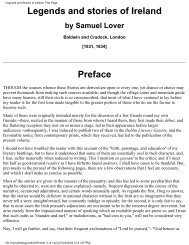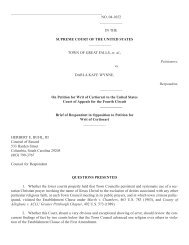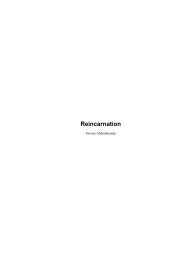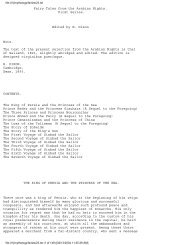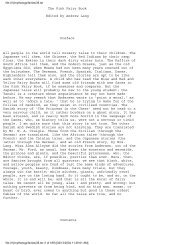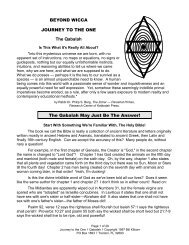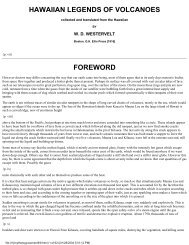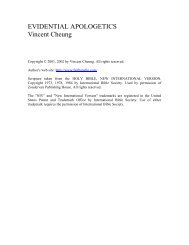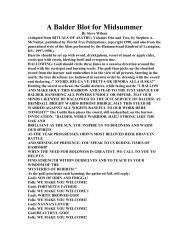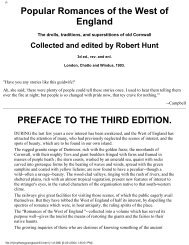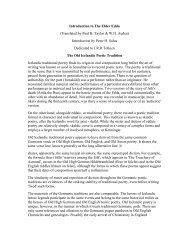Tales and Traditions of the Eskimo - Alternative Religions ...
Tales and Traditions of the Eskimo - Alternative Religions ...
Tales and Traditions of the Eskimo - Alternative Religions ...
You also want an ePaper? Increase the reach of your titles
YUMPU automatically turns print PDFs into web optimized ePapers that Google loves.
<strong>Tales</strong> <strong>and</strong> <strong>Traditions</strong> <strong>of</strong> <strong>the</strong> <strong>Eskimo</strong> - Title Page<br />
subjective taking p, <strong>the</strong> dual k, <strong>and</strong> <strong>the</strong> plural t. There are two kinds <strong>of</strong> suffixes expressing <strong>the</strong> relation to<br />
<strong>the</strong> subject itself, or to ano<strong>the</strong>r; <strong>and</strong> besides this, every suffix has its peculiar form for number,<br />
subjective, objective, <strong>and</strong> <strong>the</strong> local cases. But in order to add <strong>the</strong> above flexional letters, <strong>the</strong> nouns<br />
<strong>the</strong>mselves, in certain cases, must be somewhat modified; <strong>and</strong> <strong>the</strong> rules for this transformation are nearly<br />
<strong>the</strong> only complicated part <strong>of</strong> Greenl<strong>and</strong>ish grammar. Yet <strong>the</strong> natives would seem sometimes not to<br />
consider this transformation absolutely necessary in correct speaking, saying igdlo, house; igdlut,<br />
houses; but tupe8, tent; tov8it, or also tupit, tents. Excepting <strong>the</strong>se transformations, <strong>the</strong> numerous forms<br />
may be represented by help <strong>of</strong> a scheme which can be written on a quarto page.<br />
The verbs are divided, according to <strong>the</strong> mark <strong>of</strong> <strong>the</strong> p. 18 third person indicative, into five classes, with<br />
endings as follow: po8, rpo8, gpo8, vo8, <strong>and</strong> ao8, but each still to be conjugated according to <strong>the</strong> same<br />
scheme, which comprises all <strong>the</strong> numerous combinations <strong>of</strong> <strong>the</strong>se formsviz., numbers, persons, suffixes,<br />
<strong>and</strong> moods<strong>and</strong> still, on account <strong>of</strong> its regularity, can be written on one folio page. Negation is expressed<br />
by <strong>the</strong> additional stem ngila8, which is conjugated in a somewhat peculiar manner.<br />
In consequence <strong>of</strong> what has just been explained, personal pronouns generally are <strong>of</strong> no use. Still, some<br />
words <strong>of</strong> pronominal signification exist, used when <strong>the</strong> person must be expressed more distinctly; but<br />
even those words seem to have been formed by help <strong>of</strong> suffixes, such as uvanga, I, which perhaps<br />
originally signified, my being here. However, <strong>of</strong> demonstrative roots twelve are found corresponding to<br />
<strong>the</strong> notions here (ma), north, south, <strong>the</strong>re, above, &c. Without any addition or flexion, <strong>the</strong>y only occur as<br />
interjections, but o<strong>the</strong>rwise always as nouns, answering to <strong>the</strong> questions where, whence, which way, <strong>and</strong><br />
whereto. Of <strong>the</strong>se roots, pronouns for <strong>the</strong> third person are formed by adding na, with <strong>the</strong> sense <strong>of</strong>, this<br />
here (mána), he <strong>the</strong>re in <strong>the</strong> north, &c.<br />
The real numerals only run from 1 to 5, like <strong>the</strong> fingers on one h<strong>and</strong>, <strong>the</strong>n <strong>the</strong> fingers on <strong>the</strong> o<strong>the</strong>r are<br />
enumerated, <strong>and</strong> afterwards, if necessary, <strong>the</strong> toes on <strong>the</strong> feet. For this reason 20 is called "<strong>the</strong> man<br />
finished." The rest are expressed by some partitive word showing <strong>the</strong> number counted, as atause8, 1;<br />
mardluk, 2; pingasut, 3; sisamat, 4; tatdlimat, 5; but arfine8 pingasut, 8 (or 3 upon <strong>the</strong> o<strong>the</strong>r h<strong>and</strong>);<br />
24 is called 4 upon <strong>the</strong> second man, <strong>and</strong> 80, finishing 4 men.<br />
Construction <strong>of</strong> words.We have already mentioned <strong>the</strong> signification <strong>of</strong> <strong>the</strong> stems. These are derived from<br />
roots, <strong>and</strong> it must be supposed that ei<strong>the</strong>r several stems have a common root, or that several roots have<br />
been p. 19 related to each o<strong>the</strong>r, as, for example, 8ô8, urine; <strong>and</strong> kûk, a river. But <strong>the</strong> grammar does not<br />
explain <strong>the</strong> origin <strong>of</strong> <strong>the</strong> stems, whose formation is considered as accomplished <strong>and</strong> fixed; <strong>and</strong> here we<br />
shall only try to give an idea <strong>of</strong> <strong>the</strong>ir fur<strong>the</strong>r application in constructing words. With <strong>the</strong> exception only<br />
<strong>of</strong> <strong>the</strong> verbal ending, necessary for <strong>the</strong> formation <strong>of</strong> real verbs, words are always composed or formed by<br />
help <strong>of</strong> <strong>the</strong> additional stems, also called affixes. These are divided into (1) <strong>the</strong> transforming class, by<br />
which verbs can be converted into nouns, or nouns into verbs; (2) <strong>the</strong> formative class, by which <strong>the</strong> word<br />
remains unchanged in this respect.<br />
A selection <strong>of</strong> <strong>the</strong> most remarkable additional stems or affixes.<br />
I. ADDED NOUNS OR NOMINAL AFFIXES.<br />
1. Transforming.<br />
to8 or sso8, being or doing so, consequently a sort <strong>of</strong> nominal participle, as ajorpo8, he is bad; ajortok,<br />
file:///I|/mythology/american indian/24/24.html (18 <strong>of</strong> 317) [01/24/2004 8:57:48 AM]



